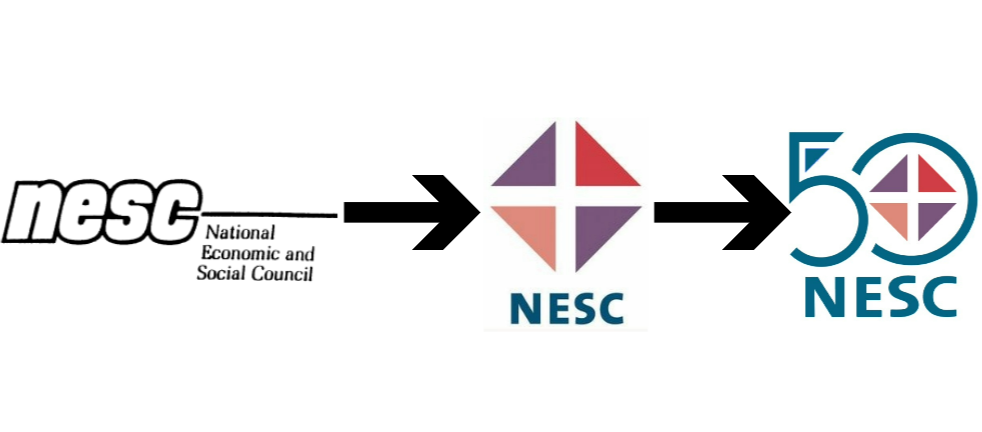You are here: Home > News & Events > 50 Years A-Growing
50 Years A-Growing
- 16 November 2023
- Topics: NESC@50
- Types: News

As part of our NESC@50 programme, we are delighted that Tom Ferris, whose great career includes being part of the first NESC Secretariat, shares his memories of the Council’s early days with us in this article.
The National Economic and Social Council: 50 Years A-Growing
Tom Ferris, Dublin, November 2023

I am delighted to accept Dr Larry O’Connell’s invitation to write about NESC in the early days. Having been part of the first secretariat, I have a unique perspective of the evolution of NESC, and it gives me great pleasure to be sharing that experience.
Shortly after NESC’s inaugural meeting on November 1973, I was interviewed by Professor Louden Ryan – the Council’s first Chair – for a job in the newly formed secretariat. I was nervous to say the least. But when he figured that I knew something about economics, Louden was interested to learn that I had been an Administrative Officer in the Department of Finance but had resigned to go and work for B&I Shipping Line. He was also interested in the fact that I was teaching transport economics in the old College of Commerce in Rathmines, where students, who were working daytime, studied at night to qualify as members of the Chartered Institute of Transport. So, I got the job, with the title of Secretary of the Economic Policy Committee. Because budget lines had not been established for NESC, I continued to be paid by B&I Shipping Line, who then sought reimbursement from the Department of Finance. Early evidence of the circular economy in operation.
During January 1974, I said goodbye to the B&I Shipping Line’s HQ at North Wall and found myself ‘camping’ in an upstairs office belonging to Trinity College off Pearse Street, for which Louden had arranged access. I always remember it was a very lively building, as downstairs was a creche and a very lively creche at that.
Later in January 1974, I met Professor Helen Burke and Catherine Keehan (Earley) who were to manage the Social Policy Committee. Helen was the Chair, and Catherine was the Secretary to that Committee. They were to become life-long friends. The third committee was the Regional Policy Committee, which was chaired by Professor Norman Gibson, a Northern Ireland academic who was making a name for himself on the Northern Ireland economy. The Secretary was Gerry Hughes, followed by Dan Brennan and then John Blackwell.
Once NESC had been established, Louden Ryan was anxious that there would be early outputs. Under Louden’s expert guidance, I drafted a very slim first NESC Report on the Irish Economy. It went through the Economic Policy Committee very quickly and was cleared by Council in a matter of weeks. And so, publication was on 1st April 1974. That pace continued. Indeed, NESC produced thirty-nine reports in the years of Louden’s leadership. All are still available on NESC’s excellent website www.nesc.ie.
While Louden Ryan set very high standards, he was extremely encouraging, generous with his time and inspirational in his leadership. And he was an expert in chairing the Economic Policy Committee and the plenary NESC Council. And it was not all plain sailing. There was healthy tension between NESC and the Department of Finance. At one NESC Council Meeting, the Secretary of the Department of Finance tried to get NESC to do extra work. Louden’s response was – “But Secretary you have a whole Department at your disposal, we only have a small secretariat.”
The secretariat did not always get all the help that was available. This issue was highlighted in Report No 32. It stated that – “In almost every field identified…for study, either background studies were not available, or if they had been prepared in Government Departments, were not made available to the Council” (Page 21, NESC, No. 32). And so, members of the NESC secretariat had to continue with their own research.
It is worth noting here that much of the Secretariat (and consultant-backed) research was necessary as there were large policy areas which were difficult to comment on due to lack of analysis and information. Far from evading its policy advice responsibilities, the Council was determined that its advice would be firmly evidence based. Hence the raft of such reports at the beginning. In the case of one NESC report, one senior civil servant, with responsibility for planning and expenditure control in an outside department, told me that the Council’s report on Social Welfare was his bible over several years. He was referring to NESC Report No.17, entitled ‘Statistics for Social Policy’, which was drafted by Eithne Fitzgerald, who was in the NESC Secretariat at various stages of 1975 and 1976.
At the same time, a criticism was circulating that NESC was not giving sound advice to Government. On that one, the NESC response was quite sharp – “If the advisory process was judged unsatisfactory, it did not necessarily follow that the fault lay with the giver (the NESC); it could well lie with the receiver (namely the Government).” (Page 9, NESC, No. 39).
It is interesting to see criticisms of those early days have continued until recently. In that regard, Dr Ciaran Casey stated in his recent book on ‘The Irish Department of Finance;1959-99’[1] that the NESC – “…had a decidedly precarious existence in this period” and that – “One fair criticism was the Council’s prolific output of reports on a wide range of subjects. This distracted from the priority issues and made it all too easy for reports to fall into obscurity. Many were written by consultants, which absolved members from developing and articulating their own views” (Pages 114 – 115).
In fact, these criticisms were addressed in two specific reports. First, in Report No 39 (page 21, NESC, No. 39), it is pointed out that “Consultants were used in the preparation of sixteen of the thirty-nine reports prepared by the Council up to the end of December 1977. In seven of these sixteen cases the consultants were from outside Ireland.” Second, Report No 32 (page 24, NESC, No. 32) pointed out that – “The use of consultants meant that first-rate expertise could be brought to bear on specialised problems, and this enabled the Council and its very small secretariat to accomplish a vast amount of work at minimal cost to the Exchequer.”
I should declare my role in relation to the foregoing debate. In a footnote to both NESC Report No. 32 and NESC Report No. 39, from which the foregoing quotations have been taken, it is stated that – “Successive drafts of the reports were prepared in the Council’s Secretariat by Tom Ferris”. I accept the acknowledgement, but I must say that the drafts were prepared under the watchful and helpful eye of Louden Ryan. I salute him as an eminent economist, a great mentor, and a loyal friend.
Louden did not go into print much about NESC. However, in an interview with Ivor Kenny he did admit that – “… the membership of the NESC was vast, well over twenty people, much larger than the old NIEC [National, Industrial and Economic Council] and certainly larger than the General Purposes Committee. You never quite developed the satisfaction of getting to know people and the way they were thinking. You never got to know them intimately. There was not the same depth of personal relationships in it. It had, however, its own secretariat and you had the satisfaction of working with a small group of bright, younger people.”[2]
Louden Ryan completed his chairing of NESC in early 1978. But a fine tradition then started whereby a series of NESC Secretariat lunches commenced. Helen Burke, Catherine Earley, Louden, and I met for lunch on a regular basis, right up to February 2017. After that, it meant visiting Louden, first in Belmont Nursing Home, and then in Brabazon Nursing Home. On these visits, I would say that Louden’s voice got softer and softer, but his mind was as sharp as ever. He died on 19 November 2018. May he rest in peace.
[1] Published by IPA, 2022
[2] Ivor Kenny, ‘In Good Company,’ Interview with Louden Ryan, 18 December 1986.


